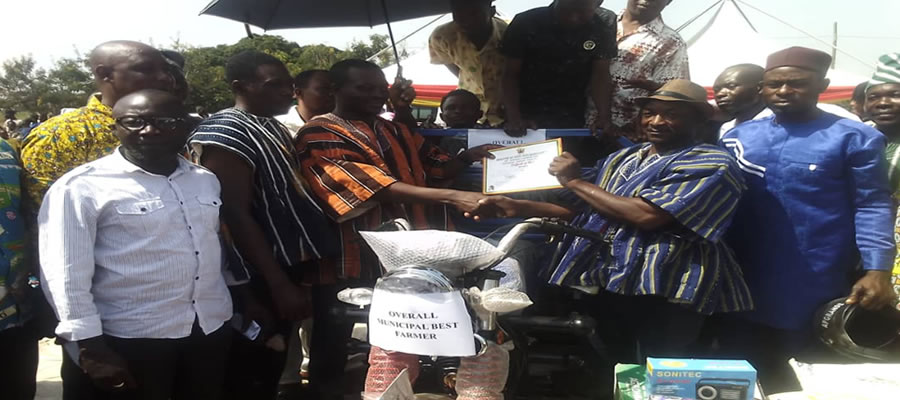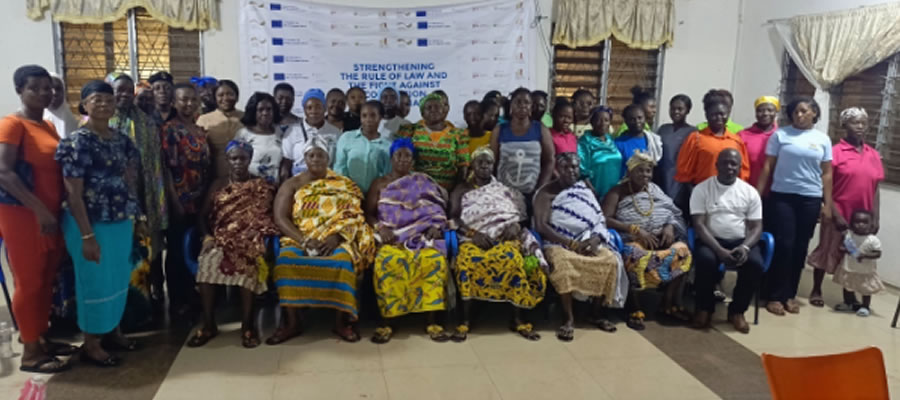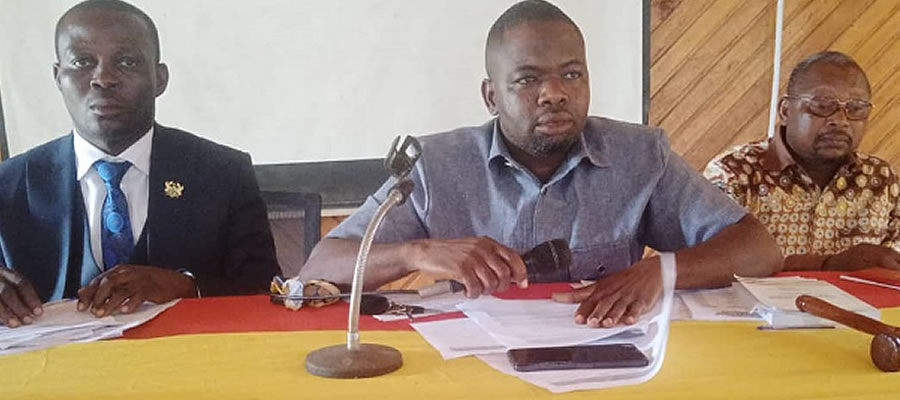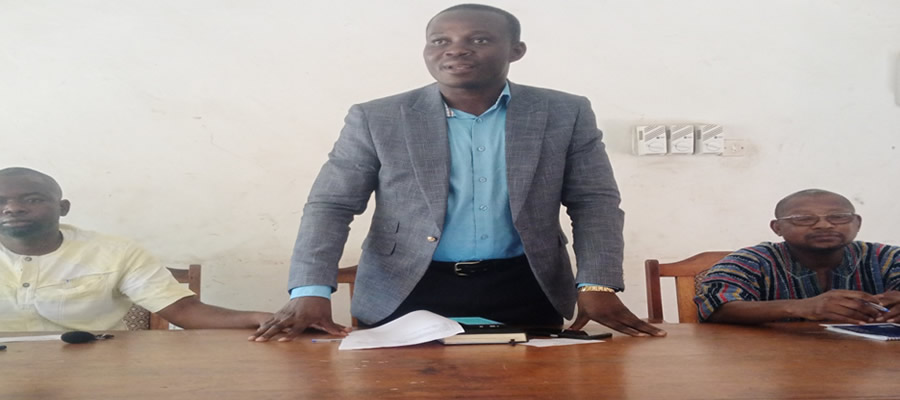

Good health is critical to socio-economic development in every locality. This section looks at the general framework under which health services are delivered in the municipality. The municipality has 18 health facilities comprising two hospitals (one public and one private), 3 health centres and 13 CHPS compounds. On staff strength, the municipality has four (4) medical doctors at the government.
National Health Insurance Authority
The National Health Insurance Authority Atebubu Office provide services to all citizens within the municipality that eliminates the cash and carry system as the policy objective. This increase access to health care services at all times.
The National Health Insurance Scheme (NHIS) is a social intervention programme introduced by government to provide financial access to quality healthcare for residents of Ghana and persons on a visit to Ghana.
The Scheme is largely funded by 2.5 percent levy on goods and services collected under the value Added Tax (VAT), 2.5 percent of social security and National Insurance trust (SSNIT) contributions per month, return on investments made by the NHIA, premium and processing fees paid by subscribers to join or renew memberships, allocations from government to the Scheme to finance claims and other operational costs and grants and foreign aid received from foreign bodies.
“The vision of the National Health Insurance Scheme (NHIS) is to be a model of sustainable, progressive, equitable national health insurance scheme in Africa and beyond”
The Object of the National Health Insurance Authority (NHIA) and by extension the Atebubu-Amantin Municipal health Insurance Office is to attain universal health insurance coverage in respect of persons resident in the country and persons not resident but who are on a visit to this country and to provide access to health care services to the persons covered by the Scheme.
The mandated functions of the Atebubu-Amantin Municipal Health Insurance Office among others are to;
Educate the populace within the Municipality on the operations and activities and policies of the NHIA through the various available media, register members of the National Health Insurance Scheme, issue identity cards to members of the National Health insurance Scheme, enroll the poor and vulnerable groups such as pregnant women, the disable, indigents and others onto the NHIS to ensure equity and protect the poor against financial risk on health care delivery.
Health Facilities GHS
Management of health facilities in the Municipal is the responsibility of the Ghana Health Service (GHS), religious missions, and the private sector. There are a total of thirteen (13) health facilities located in various parts of the district. This is made up of one Municipal Hospital, two Health Centers, five CHPS compounds, four Community Clinics and a Maternity Home (See Table 1.10). There are 3 under construction which one is complete (Dobidi/Nkwanta, Yaw Tuffour and Sanwakyi).
In spite of the fact that there are quite a number of health facilities with varying categories and functions in the district, problems still persist with regards to the number of health personnel. The MUNICIPAL has one medical doctor, 41 Enroll nurses, 80 Community Nurses, 18 Heath Assistance,1 Physician Assistance and 29 Professional Nurses. It has a doctor-patient ratio of 1: 130.000whilst the Nurse – Patient ratio is 1:770.
Family Planning GHS
Family Planning services are provided at all the health facilities in the Municipal to assist couples in their reproductive stages. These services are designed to prevent unplanned pregnancies, space births, treat infertility and improve reproductive health. Some of the family planning methods and/or services available to the people include condom use, oral pills, injectable, IUD and Norplant, as well as natural family planning methods. It is estimated that 7,217 persons representing 32.3% of the adult population have so far registered for family planning services and counseling.
National Health Insurance Scheme (NHIS)
The Atebubu Municipal Assembly has established a MunicipaL Mutual Health Insurance Scheme in an attempt to provide an opportunity to all registered persons to have unhindered, cash-free and efficient access to health care services at all times. The scheme has seen tremendous increase in the number of registered persons. For instance, in 2015, 3293 persons had registered with the scheme as indigenes, 108 under SSNIT and 3,154 as informal, in 2016, 76 indigenes registered, 164 under SSNIT and 3528 people have been duly registered and issued with identification cards which qualify them to access health care services free of charge. There was a drop with regards to renewals comparing to the two year periods.
Mobilization of membership is carried out through community sensitization, durbars and visitation to identifiable groups. However, effective membership drive is constrained by widespread poverty within the district, politicization of the scheme and uncertainty about the benefits to be derived from joining the scheme. The effective operationalization of the scheme in the Municipal is also severely hampered by lack of transport facilities such as motorbikes and vehicle, mass communication equipment, financial and logistical inadequacies and conflicts between the Health Insurance Board and Management of the Scheme.
Health Sector Collaborators
A close collaboration exists between the Municipal Health Management Team (DMHT) and the Municipal Assembly (DA). An enormous portion of the District Assembly Common Fund (DACF) is channeled into health related projects such as the provision of potable water in guinea worm endemic areas. Apart from the DA, the Ghana Education Service (GES), the Ministry of Food and Agriculture (MOFA), the National Commission on Civic Education (NCCE) and the National Disaster Management Organization (NADMO), there are two non-governmental organizations also supporting the delivery of health services in the district.
These are the World Vision International (WVI) and the Association of People for Practical Life Education (APPLE). The World Vision International has for instance been organizing health and nutrition workshops in several communities to promote their living conditions. They also support immunization programmes and drill boreholes in guinea worm endemic areas.
Challenges in Health Delivery GHS
The delivery of health services in the Municipal is beset with a number of challenges ranging from inadequate professional staff, inadequate transport facilities, and inadequate residential and office accommodation to inadequate financial resources. The Municipal has only one professional doctor to serve a population of 92,951. This is because the medical superintendent is on transfer and there has not been any replacement yet. The Doctor – Patient ratio is pegged at 1:100,000 whilst the Nurse – Patient ratio is 1:3,300. There is also very little opportunity for upgrading skills of health staff.
The health outfit has only three pick-up vehicles for their operations with two of them rendered unserviceable. A few motorbikes are available but are subject to frequent breakdowns due to long usage. The Municipal Health Directorate is housed in only four rooms at the Municipal Assembly premises which make the work environment not conducive. Staff accommodation is insufficient and in most cases the available premises have functionally deteriorated. Financial resources are meager and cannot meet their huge operational expenditure. There are generally no proper incentives for staff working in very difficult terrain.
Nutrition Security
The people in the Municipal are mainly subsistence farmers who are mainly engaged in the production of food crops such as yam, cassava, maize, millet, rice, beans etc. The major vegetables grown are garden eggs, tomatoes and pepper. Livestock rearing is also part of the economic activity of the people. Animals reared include cattle, goats, sheep and pigs.
About 6% of the total workforce is engaged in industrial activities which are mainly small-scale and basically agro-based or wood-based. A few artisans could also be found.
The main sources of water in the Municipal are rivers, streams, boreholes and hand-dug wells. The Municipal is the single highest endemic in terms of guinea worm infestation in the region, thus provision of potable water stands high on the agenda of the DHMT and the Municipal Assembly.
The World Vision International (WVI), who initiated the water and sanitation (WATSAN) concept in the district, has been very supportive in the provision of hand-dug wells, boreholes, laundry pads and household ventilated improved pits (VIP) to several communities throughout the district.
There are so many interventions put in place to enhance the nutritional status of people in the Municipal especially children under five years. Some of these interventions are as follows
This is where the weight of children is monitored every month to check whether mothers are giving the right nutritious food to their children or to check whether mothers are practicing good exclusive breastfeeding or complementary feeding. Mothers whose children weights are not improving are given nutritional counseling.
That is mothers are counseled one on one to probe further the reason behind the decrease or static in weight of the child for appropriate counseling. In vein children are also given vitamin A supplementation to improve upon their eyesight, proper skin development, improve the immune system etc. vitamin A is given at six (6) months interval, thus children 6-59months.
Community Infant and Young Child Feeding (C-IYCF)
This is where health workers are trained from the various health facilities on IYCF where mother support and action- oriented groups are formed. In these groups, mothers are counseled and taught in all aspects concerning good nutrition and general care of the child such as importance of exclusive breastfeeding for infants, how to start and do complementary feeding, good personal and environmental hygiene, good position and attachment to the breast during breastfeeding, breastfeeding difficulties, how to feed a sick child, nutrition for pregnant and breastfeeding women etc.
In these groups, mothers are educated or taught how to keep good sanitation to prevent children from getting sick especially diarrhea because diarrhea causes the child to lose all food or breast milk taken eventually causing the child to be malnourished. Mothers are also educated to give clean water to their children when starting complementary feeding.
Community management of acute malnutrition (CMAM)
CMAM is a Community-Based Management of Acute Malnutrition. CMAM is aimed at identifying children from 6-59months with SAM. SAM is severe acute malnutrition. To get the children with SAM, the mid- upper- arm circumference (MUAC) is measured with a special tape known as MUAC tape. Children with MUAC measurement less than 11.5cm or have bilateral pitting oedema are qualified cases for SAM. Most children with SAM without medical complications and are well and clinically alert with good appetite are treated as outpatients (OPC) at accessible, decentralised sites. Children with SAM and medical complications are treated as in-patients (IPC). At the OPC sites, a specially prepared food and medicine is used to treat these children.
This food and medicine is called ready- to -use therapeutic food (RUTF). RUTF is for SAM cases. Children are treated within a period of 16weeks with the RUTF. Within the 16 weeks, children who gained the MUAC measurement of 12.5 cm or more for two consecutive weeks, with no oedema or no medical complications are discharged. The Municipal runs only OPC for CMAM cases. Children with CMAM IPC cases are referred to facilities that run IPC within the region.
Iodine is one of micronutrients found in food grown on land and sea foods. This microelement helps the body to grow and stay healthy. But due to the constant tilling of the land, most of the iodine is washed into the sea by rain fall making our land and the food crops not having enough iodine. The absence of this important nutrient in the body has a group of disorders termed as Iodine Deficiency Disorders (IDD). E.g. of these disorders include mental retardation, goiter, cretinism, decrease in the health of female adolescents and adults etc.
These groups of disorders (IDD) are of public health concern in the Municipal because they cannot be cured but prevented. To rectify this situation, iodine is therefore added to salt by factories for everybody to have enough iodine. The salt is therefore monitored by conducting iodated salt survey in households and markets to ensure that all the salts supplied to households are iodized. This is due to distinct pattern of household iodized salt adequacy and use which exists in different communities, related to the production source, wholesale or retail relations with markets and preservation methods.
World Vision (SATISFY) in collaboration with Ghana Health service, Environmental health, Agricultural Department etc. trained community based farmers on the following essential crops and livestock keeping. Improved variety cassava farming, soya beans and sheep, goat, pig etc. The improved cassava is processed into gari fortified with soya flour to improve the nutrition value of the gari because soya beans contain almost all essential nutrients.
The above mentioned livestock contains all the essential nutrients the body needs for proper growth and development. Yellow flesh sweet potato (YFSP) and soya biscuits are also prepared using soya flour which is high in nutrients during food demonstrations. YFSP is a food source which is high in vitamin A and it’s piloted in the district. This food can be eaten raw or cooked.
It is also prepared into powder which can be added to soups, tea, and porridge for both adults and children. Mothers are also taught cerelac preparation using local ingredients fortified with soya flour. Community members are also taught how to prepare Yoghurt using our locally available cow milk which also serves as a rich source of energy and other nutrients etc. the unit also collaborate with the Municipal school feeding implementation committee (DIC) to embark on monitoring and supervision to schools implementing the school feeding program to ensure children are fed with adequate nutritious food.
This is one of the nutrition interventions where iron foliate acid is given the pregnant women during anti natal services (ANC). This is done to supplement any iron lost in the mother during pregnancy. Iron is one of the micronutrient when taken into the human body; enhance the formation of red blood cells for proper growth and development.
Its deficiency results in anemia affecting children and pregnant women. During this session, pregnant mothers are also given nutritional counseling to eat locally available foods that are high in iron content to prevent any future occurrence of anemia which will result in any complication or death of the mother or the fetus.
Basically the above mentioned interventions are what the unit runs in the Municipal when it comes to the area of nutrition. Hope to carry out more nutrition interventions if the Municipal Assembly could support the nutrition unit financially.
Date Created : 3/27/2023 4:20:24 AM












 facebook
facebook
 twitter
twitter
 Youtube
Youtube
 +233 593 831 280
+233 593 831 280 0800 430 430
0800 430 430 GPS: GE-231-4383
GPS: GE-231-4383 info@ghanadistricts.com
info@ghanadistricts.com Box GP1044, Accra, Ghana
Box GP1044, Accra, Ghana